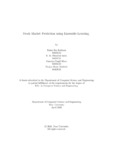| dc.contributor.advisor | Majumdar, Mahbub | |
| dc.contributor.author | Rabbani, Rakin Bin | |
| dc.contributor.author | Amin, B. M. Fahad-ul | |
| dc.contributor.author | Khan, Sumaiya Tanjil | |
| dc.contributor.author | Mahbub, Farjiya Benta | |
| dc.date.accessioned | 2021-03-21T05:49:32Z | |
| dc.date.available | 2021-03-21T05:49:32Z | |
| dc.date.copyright | 2020 | |
| dc.date.issued | 2020-04 | |
| dc.identifier.other | ID: 16101213 | |
| dc.identifier.other | ID: 16101251 | |
| dc.identifier.other | ID: 16101212 | |
| dc.identifier.other | ID: 16301033 | |
| dc.identifier.uri | http://hdl.handle.net/10361/14360 | |
| dc.description | This thesis is submitted in partial fulfillment of the requirements for the degree of Bachelor of Science in Computer Science and Engineering, 2020. | en_US |
| dc.description | Cataloged from PDF version of thesis. | |
| dc.description | Includes bibliographical references (pages 35-37). | |
| dc.description.abstract | An unpredictable sector of finance market which involves three major roles: investors, buyers and sellers is called a stock market. Also stock prices may not only change the future economy of a country but also have direct effects on the current economic activities of the country. Forecasting stock market is acquiring more attention due to its expected high profit. But the prediction part of stock markets is considered as quite a challenging task. Though there are various techniques available for forecasting stock price but the number of methods for forecasting the stock market accurately is less than usual. Another way of determining future value as in rise or fall of the future stock price is known as data analysis. The purpose of this paper is to discuss how accurately the price of stocks in the US stock market can be predicted, by generating the best possible factors for particular stocks in the US stock market using machine learning algorithms. After conducting our preliminary research and then some, we found that it is quite difficult to predict the price fluctuations of stocks as the market is highly volatile. Furthermore, the number of uncertain variables in the equation which makes it hard to isolate any one or few factors that can be used to accurately predict price fluctuations. Therefore, for our trial runs, we tried to isolate the best factors that can be used to predict the prices of stocks with sufficient accuracy. For our approach, we implemented Gradient Boosting, Random Forest, Naive Bayes, AdaBoost, Logistic Regression and SVM to run on our dataset. Based on the outcome of these algorithms we will take the decision whether to go long or short for a particular stock. | en_US |
| dc.description.statementofresponsibility | Rakin Bin Rabbani | |
| dc.description.statementofresponsibility | B. M. Fahad-ul-Amin | |
| dc.description.statementofresponsibility | Sumaiya Tanjil Khan | |
| dc.description.statementofresponsibility | Farjiya Benta Mahbub | |
| dc.format.extent | 37 pages | |
| dc.language.iso | en_US | en_US |
| dc.publisher | Brac University | en_US |
| dc.rights | Brac University theses are protected by copyright. They may be viewed from this source for any purpose, but reproduction or distribution in any format is prohibited without written permission. | |
| dc.subject | Machine Learning | en_US |
| dc.subject | Time Series | en_US |
| dc.subject | US Stock market | en_US |
| dc.subject | Stock Prediction | en_US |
| dc.subject | Gradient Boosting | en_US |
| dc.subject | Random Forest | en_US |
| dc.subject | Naive Bayes | en_US |
| dc.subject | AdaBoost | en_US |
| dc.subject | Logistic Regression | en_US |
| dc.subject | SVM | en_US |
| dc.subject | Feature reduction | en_US |
| dc.title | Stock market prediction using ensemble learning | en_US |
| dc.type | Thesis | en_US |
| dc.contributor.department | Department of Computer Science and Engineering, Brac University | |
| dc.description.degree | B. Computer Science | |

